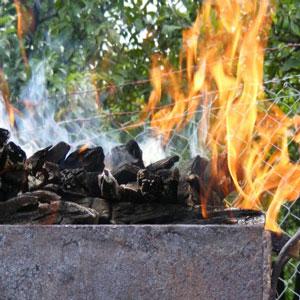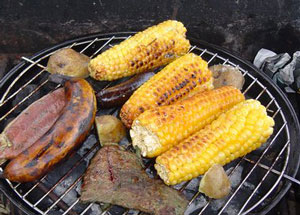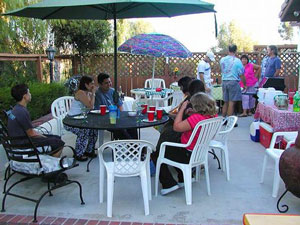
The waft of a barbecue’s finest — burgers, brats, hot dogs, skewers, steaks, ears of corn, and any other favorite that fits on the grill — is a wonderful sign that the long winter is ending, and the warmer months have arrived. The wind gently calls the family from the deep recesses of the home, outside, to celebrate the reemergence of life.
The wind, however, is not discriminatory to just the household family. The aroma of a BBQ ignores the property line boundaries, and invites all of the neighbors to gather for a community meal. While a BBQ is one of the signature signs of summer, there is another just as important component to grilling. Since the beginning of human existence, a fire and a meal helped to gather people to dine, share and catch-up on the happenings of the day.
The importance of food to humans is so vital that many of our customs derive from and/or around a meal. In the article, “The Anthropology of Food and Eating,” written by Sidney W. Mintz and Christine M. Du Bois, the authors find that, “Next to breathing eating is perhaps the most essential of all human activities and one which much of social life is entwined.” From prehistoric campfire gatherings to modern day get-togethers, meals unite people into a collective society. Whether the meal is cooked on a stove, or grill, an assembly of people is the ultimate outcome.
 Barbecue as it is known today is innately American in its roots. The origin of the word barbecue many theorize is to have begun with the Spanish, as a description of the Caribbean Natives method of cooking. The Spanish coined the practice of slow-cooking meat atop a wooden platform as barbacoa, according to Claire Suddath in the Time article “A Brief History of Barbecue.” Suddath says the American South furthered the technique of barbecue in the 19th century with pork as the preferred meat and cornbread as the primary side dish.
Barbecue as it is known today is innately American in its roots. The origin of the word barbecue many theorize is to have begun with the Spanish, as a description of the Caribbean Natives method of cooking. The Spanish coined the practice of slow-cooking meat atop a wooden platform as barbacoa, according to Claire Suddath in the Time article “A Brief History of Barbecue.” Suddath says the American South furthered the technique of barbecue in the 19th century with pork as the preferred meat and cornbread as the primary side dish.
Today, every region of the country boasts that it possesses the best barbecue with varying distinctions and qualities of BBQ from one location to another. Suddath says the tomato based sweetened sauce graces pulled-pork in Memphis, North Carolina uses a vinegar based sauce applied to the whole hog and smoked, Kansas City barbecue is a dry rub placed on ribs, and a great deal of Texas barbecue deals with beef on the grill. Like any meal, creativity, and mixing and matching regional methods to the barbecue are a great way to experiment with tastes and textures, and design a unique meal.
Barbecue also integrates kids into the mealtime preparation because it allows them to practice their culinary skills with skewers, and feel a sense of accomplishment by providing for the community. However, remember to watch the children closely as they prepare the skewers.
 Precutting fruits is one option that lets the children pick, and choose what to place on their skewers. The fruits great for grilling include pear and apple wedges, grapes, peaches, or nectarines that are half-sliced, cut up mangoes, pineapple, and bananas, sliced kiwi, and whole strawberries. Uniformly cut the fruit so that it cooks over the barbecue evenly, and brush it with vegetable oil to prevent sticking. Also apply butter, cinnamon, or sugar to the fruit for additional flavor. Since fruit is softer and contains more water, it grills quickly in about 5 minutes — the softer the fruit the faster it will grill.
Precutting fruits is one option that lets the children pick, and choose what to place on their skewers. The fruits great for grilling include pear and apple wedges, grapes, peaches, or nectarines that are half-sliced, cut up mangoes, pineapple, and bananas, sliced kiwi, and whole strawberries. Uniformly cut the fruit so that it cooks over the barbecue evenly, and brush it with vegetable oil to prevent sticking. Also apply butter, cinnamon, or sugar to the fruit for additional flavor. Since fruit is softer and contains more water, it grills quickly in about 5 minutes — the softer the fruit the faster it will grill.
As well as congregating with neighbors outside, and sharing that connection of food with the kids, another even more important component is the one offered by nature in its ability to create positive and uplifting emotions in a person’s psyche. A home is confining and determined as owned by another, but outside, the lines are not as defined, and the community is more relaxed in a shared environment. The article, “Healthy nature healthy people,” finds that people enjoy a healthier life and higher levels of satisfaction at home, work, life in general because it reduces stress. A barbecue amasses the qualities of family, community, and nature into one public gathering where the indiscriminate flavors welcomes neighbors for a meal to celebrate the community.
Sources
Kolker, Ann. “Tips, ideas and recipes for a healthier family barbecue.” Nourish Interactive. June 2010, http://www.nourishinteractive.com/parents_area/healthy_family_nutrition_newsletter/healthy_family_bbq_kids_vegetables_barbecue_foods_grilling_tips.
Maller, Cecily, Mardie Townsend, Anita Pryor, Peter Brown, and Lawrence St. Leger. “Healthy nature healthy people: ‘contact with nature’ as an upstream health promotion intervention for populations.” Oxford Journals 21(1) March 2006, http://heapro.oxfordjournals.org/content/21/1/45.full.
Mintz, Sidney W. and Christine M. Du Bois. “The Anthropology of Food and Eating.” Annual Review of Anthropology October 2, 2002, http://web.ebscohost.com.ezproxy.aclin.org:2048/ehost/pdfviewer/pdfviewer?sid=6d4e3080-20a0-46f0-8265-5b29b1237283%40sessionmgr4&vid=1&hid=13.
Suddath, Claire. “A Brief History of Barbecue.” TIME. July 3, 2009, http://www.time.com/time/nation/article/0,8599,1908513,00.html.
